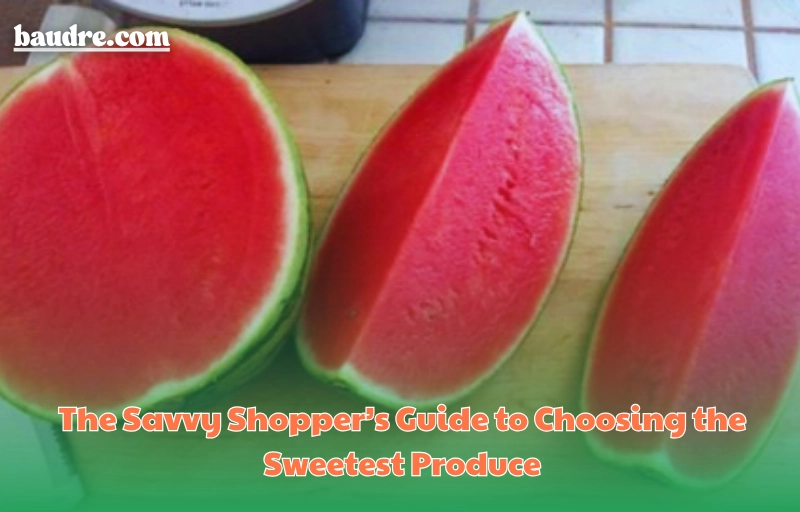Nothing says summer quite like a slice of perfectly ripe, sweet watermelon. But choosing the best one from the pile at the grocery store or farmer’s market can feel like a guessing game—unless you know exactly what to look for. With a few expert tips and a keen eye, you can consistently pick watermelons that are bursting with natural flavor. This smart shopper’s guide breaks down everything you need to know to find the juiciest, most delicious watermelon every time.

Start with the Field Spot – Nature’s Ripeness Indicator
Look for a Rich Yellow Color
When scanning the watermelon bin, flip the fruit over to examine its underside. You’ll find a discolored patch where the melon rested on the ground during ripening. This is called the field spot, and it’s one of the most important clues to determine if a watermelon was allowed to mature on the vine.
A deep yellow or rich orange field spot indicates that the melon had enough time in the sun to develop natural sugars and full flavor. This means the fruit ripened properly, and you’re likely in for a sweet, juicy treat.
Avoid melons with a white or very pale field spot, as these were likely picked too early and might taste bland or underdeveloped.
Inspect the Rind for Sugar Scars and Surface Texture
Brown Webbing Is a Good Sign
At first glance, brown web-like marks on a watermelon might seem like imperfections—but don’t be fooled! These patterns, often called “sugar scars” or “bee kisses,” are actually great signs of quality. They’re formed during the pollination process when bees transfer pollen between the flowers.
The more webbing you see, the better. These scars are indicators that the watermelon was well-pollinated, which typically leads to higher sugar content and, ultimately, a sweeter fruit. So, instead of picking the smoothest watermelon, opt for one with these natural markings.
Understand Watermelon Shapes – Male vs. Female
Round Is Sweeter, Oval Is More Watery
It might sound odd, but watermelons can generally be classified as either “male” or “female.” This doesn’t refer to the fruit’s biology, but rather its shape and characteristics:
- Male watermelons tend to be elongated or oval-shaped. They usually contain more water and are better suited for hydration, but they’re not always the sweetest.
- Female watermelons are typically rounder and plumper. These are the ones that tend to be sweeter and more flavorful.
So, if your goal is to enjoy a sweet, mouthwatering snack, go for the rounder melons.
Size Isn’t Everything – Go for Heaviness and Balance
Weight Matters More Than Bulk
Don’t be tempted by the biggest watermelon in the bunch. A large melon may seem impressive, but that doesn’t guarantee better taste. In fact, oversized watermelons can sometimes be too watery and may lack the concentrated flavor you’re looking for.
Instead, pick a watermelon that feels heavy for its size. This heaviness is a reliable indicator that the fruit is packed with juice and has a good sugar-to-water ratio. You also want to choose a melon that is evenly shaped without lumps, bumps, or deformities, which may suggest inconsistent ripening.
Bonus Tips to Maximize Sweetness and Quality
Give It a Knock
One old-school trick is to give the watermelon a gentle knock with your knuckles. A deep, hollow sound usually means the fruit is ripe and full of juice. If the sound is dull or flat, it might be overripe or under-ripe.
Check the Stem or Tail
If your watermelon still has a bit of the stem or tendril attached, that can tell you something, too. A dried, curly brown tendril near the stem is another good sign that the melon ripened naturally on the vine. A green stem usually means it was harvested prematurely.
Why It Pays to Choose the Right Watermelon
When you select the right watermelon, you’re not just picking a tasty snack—you’re maximizing value and minimizing waste. A sweet, ripe watermelon:
- Makes for an ideal summer treat
- Is perfect for picnics, BBQs, or fruit salads
- Offers a hydrating, low-calorie dessert
- Can be used in smoothies, sorbets, or refreshing drinks
There’s nothing more disappointing than slicing into a flavorless watermelon, especially when it’s the highlight of your warm-weather menu. Using these tried-and-true selection tips will help you avoid that pitfall.
Final Thoughts – Sweet Success at Every Purchase
Choosing the perfect watermelon doesn’t have to be a gamble. With a little knowledge and a few observational tricks, you can consistently bring home the sweetest, juiciest melons of the season.
From spotting a golden field spot to reading the signs of pollination and picking the right shape and weight, these expert-level insights turn you into a savvy produce shopper. Your next watermelon won’t just look good—it’ll taste incredible too.
Tip: Want to go even further? Chill your ripe watermelon in the fridge for a couple of hours before serving. The cool temperature enhances the sweetness and turns every bite into a refreshing summer delight.
Disclaimer:
The information provided in this article is for general educational purposes only and is based on widely accepted fruit selection tips. Results may vary depending on individual produce and growing conditions. This article does not offer professional or agricultural advice. Always use your best judgment when selecting and consuming fresh fruit.
